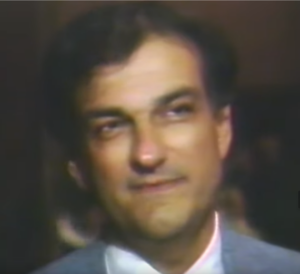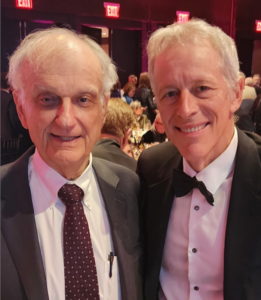1987 video of Warren Buffett; The 'I missed it' trap; Lessons from Chris Stavrou; An incredible story from the front lines in Ukraine
1) I thought I had seen every old interview Warren Buffett did...
But I missed this one, which aired in 1987: Warren Buffett Second "Adam Smith's Money World" Interview.
As I watched it, I was thinking to myself: Had I been an investor back then (I was still in college and had nothing but student debt!), would I have had the good sense to see the obvious – that Buffett was an investing genius – and bought Berkshire Hathaway's stock (BRK-A), which was then trading at $3,900 per share?
After all, it was obvious to my good friend Chris Stavrou, who briefly appears in the video (at 6:12), saying: "Warren Buffett is certainly the greatest investor of the post-World War II period and perhaps the greatest investor in history."
But in truth, I'm not so sure – I think the answer to that question would depend on what phase of my investing career the opportunity appeared.
Today, I would buy Berkshire all day long... But early in my career, I probably would have sucked my thumb and missed it because I often fell into the "I missed it" trap, which I discussed in this August 26 essay: The Three Most Dangerous Words in Investing Aren't What You Expect. Excerpt:
The common cliché on Wall Street is that the four most dangerous words in investing are, "This time is different"...
But I've found a three-word phrase that's uttered just as frequently... and is arguably even more dangerous:
"I missed it."
You've probably grumbled these words to yourself before, as you passed on a stock you were considering buying... and then watched as it marched to new high after new high.
The critical lesson here is that just because a stock has run up a lot doesn't necessarily mean it's too late to buy.
Today, I'll show you why this simple, three-word phrase can be so misleading...
In my decades as a value investor, I've seen it time and time again.
Value investors like me tend to look in the bargain bin for beaten-up stocks that are trading at 52-week (if not multiyear) lows. They get a sense of satisfaction from getting a better deal than the guy who bought it a month or a year ago.
It's a great strategy if – and this is a big if – you can correctly identify companies whose fundamentals turn around. The key here is to avoid value traps: the companies that never turn around, and thus their businesses (and stocks) keep declining and declining...
But what about stocks that never really fall out of favor such that they end up in the bargain bin? We value investors often miss them.
Later in the essay, I gave this example:
My friend Chris Stavrou, who ran a small hedge fund called Stavrou Partners for decades, bought shares of Warren Buffett's Berkshire Hathaway (BRK-A) back when he was a stockbroker in the 1970s.
Chris started buying it for his clients around $400 a share, even after it had risen more than 2,000% over the previous decade because he didn't fall into the "I missed it" trap.
A decade later, he opened up his own hedge fund. By then, Berkshire was trading at an all-time high of $1,800 per share.
So did he say to himself, "Wow, this stock has moved up a lot – I think I'll wait for a pullback" or "Drat, I missed it"?
No. He saw that it was a great company run by a brilliant investor and the stock was still attractive at $1,800. So he bought it for his nascent fund...
Needless to say, Chris wasn't selling (in fact, he was probably still buying) the stock in 1987...
And then he did something even more important than buying the right stock: He didn't sell!
Chris didn't sell when BRK-A shares soared past $5,000, $10,000, $25,000, $50,000, $100,000, $250,000, and even $500,000 (they closed Friday at $544,190).
He didn't sell when the stock grew to become more than 50% of his fund.
He didn't sell when he closed his fund (he distributed to stock in kind to himself and his investors).
To this day, long into retirement, Chris still owns the BRK-A shares he bought a half-century ago.
It's an incredible story about how you only have to be right about one thing, if you stick with it for decades, to completely transform your financial fortunes.
"Ah," you might be saying, "but what Chris did is one in a million – impossible to replicate."
Not at all...
Look at the list of the world's richest people. The majority of them are people like Elon Musk, Jeff Bezos, Larry Ellison, Mark Zuckerberg, Bill Gates, Larry Page, Sergey Brin, Walton family members, Michael Bloomberg, and, of course, Buffett himself, who put nearly all of their eggs in one basket – a company they controlled – and then held on for decades.
Of course, if your goal is to make billions of dollars, it helps if you're the largest/controlling shareholder – but, trust me, Chris is doing just fine...
The primary goal of me and my team at Stansberry Research is to find stocks like these for our subscribers – and then ride out inevitable short-term turbulence and drawdowns to hold them for years, ideally decades.
By the way, here's what Chris looked like in that 1987 video:

And here's a picture of us earlier this year:

2) A huge thank you to my many friends and readers who donated more than $28,000 to my Ukraine humanitarian campaign (www.taps.org/Tilson) for my birthday and helped motivate me at the World's Toughest Mudder. (It worked – I ran 72 miles!)
A good chunk of what I've raised recently will go to support my Ukrainian friend Artem and his unit of 11 Legionnaires (foreign fighters) – including two Americans, Jack and Tex – called the Reaper Group. Here's a picture of them – from left to right are Artem, Zac (a Canadian), Jack, and Tex:

These four brave, skilled men just completed an extraordinary mission, going within 100 meters of enemy lines for four days and doing some serious damage to the invaders.
It's an incredible story, which I detailed in a Facebook post here.
Best regards,
Whitney
P.S. I welcome your feedback – send me an e-mail by clicking here.

